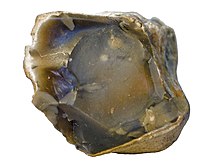Our website is made possible by displaying online advertisements to our visitors.
Please consider supporting us by disabling your ad blocker.
Flint



Flint, or flintstone, is a kind of sedimentary rock, made of silica.
Bands of flint are found embedded in chalk and other kinds of soft limestone.
When the chalk is eroded, the hard flint nodules survive as pebbles on a shingle beach. It may happen that the pebbles later get cemented into another rock, such as a puddingstone. In this way, they make up a sedimentary rock for the second time.
Previous Page Next Page


